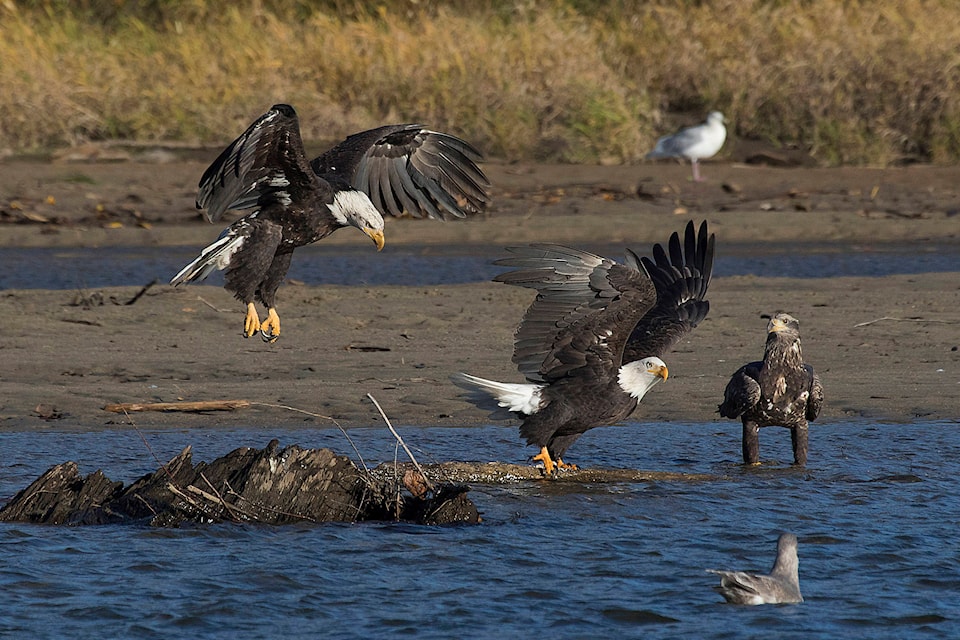David Hancock has been in love with eagles since he was a teen flying a plane over the Gulf Islands, counting their nests.
Now, more than 65 years later, the eagle biologist continues to research the birds he loves. And it’s coming up to a busy time for Hancock.
Starting in late October and early November, thousands of bald eagles will be flying down to the Fraser Valley to feast on spawning salmon and to escape the frozen lakes of their home territory in Northern Canada and Alaska.
“These wintering birds, they just want to get out of the cold Arctic,” Hancock explained, calling from his car parked near the Chehalis River estuary.
It’s “a great place for raising young, because every lake it full of fish. But they’re frozen solid until April, so they’re down here to freeload until their lakes are going to open up.”
RELATED: Thousands of eagles to return to Fraser Valley
Many of these birds will travel down to Vancouver Island or Metro Vancouver, notably feasting at the Vancouver Landfill or at Boundary Bay, coming into contact with a number of the Fraser Valley’s local bald eagle population. But most will stop in Harrison Mills to feast on salmon at what Hancock calls “the most productive river in all of Canada.”
“This little river system here is the most productive river in all of Canada for salmon,” Hancock said about the Harrison River.
“It’s not just the Harrison — that’s the best one. But of course, the Stave and the Pitt, all the rivers along here have some salmon. And that’s the reason we get this great huge wintering population.”
In the Harrison Mills area, residents can expect to see between 200 and 500 eagles arriving each day throughout November and December.
Throughout the course of the winter, the area could see up to 35,000 birds visiting the local waterways and wetlands to feast on spawning salmon.
There are some concerns however.
This year, the Department of Fisheries projected an extremely low return of sockeye salmon, with expected numbers around 600,000 rather than the previously anticipated five million. Numbers for many of the other species of salmon were also projected to be down.
RELATED: B.C. sockeye returns drop as official calls 2019 ‘extremely challenging’
“That’s why I’m out here. I’m concerned,” Hancock said from his parking spot on Morris Valley Road. He had been out counting eagles and salmon over the weekend.
“The eagles are still going to come through, the question is are they going to be able to stay? Is there going to be their dinner table set the way they would like it?” he asked. “I don’t know.”
He is, however, optimistic.
Hancock saw a large number of dead and spawning chum salmon in the river. If river levels drop, as they often do in November, there could still be plenty of fish for the eagles.
“I’m still optimistic that we could have quite a good peak for the eagles,” he said.
On Saturday, Nov. 16 and Sunday, Nov. 17, thousands of people will be joining the eagles along the Harrison River for the 22nd annual Fraser Valley Bald Eagle Festival.
RELATED: Fraser Valley Bald Eagle Festival explodes in popularity, draws thousands to Mission, Harrison Mills
Taking place in Mission and Harrison Mills, the festival will give people a chance to learn more about the eagles through interpretive talks and even boat tours.
Hancock will be there both days of the festival, as he has been for the last 21 years. He keeps on returning because of his love of eagles, but also because of how important it is to share the diversity of the Harrison ecosystem with visitors.
“The whole thing is an appreciation of this incredible river system,” Hancock said. “This is by far the world’s largest gathering of eagles. By far.
“Brackendale gets one-fifth of it; the big place up in Alaska gets a third to a quarter. We get by far the world’s biggest gathering of eagles,” he continued.
“And the eagles and all the salmon are only for one thing: that we have unpolluted, fresh water.”
That’s what people need to understand when they come to the festival, he said.
“You only have this great amount of salmon and eagles because we have a pure, wonderful river system. And we want to keep it that way.”
grace.kennedy@ahobserver.com
Like us on Facebook and follow us on Twitter
